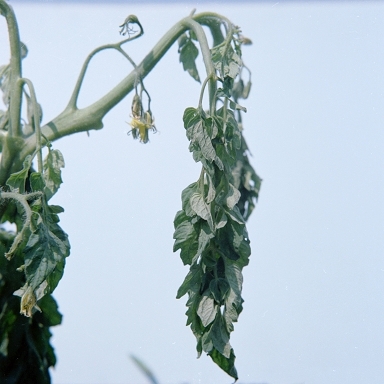|
Ralstonia Pseudosolanacearum
''Ralstonia pseudosolanacearum'' is a soil-borne bacterium. It is a vascular phytopathogen that infects host plants through the root system causing wilting disease that causes loss in a wide range of crops. ''R. pseudosolanacearum'' is Gram negative and was originally identified as ''Ralstonia solanacearum ''Ralstonia solanacearum'' is an aerobic non-spore-forming, Gram-negative, plant pathogenic bacterium. ''R. solanacearum'' is soil-borne and motile with a polar flagellar tuft. It colonises the xylem, causing bacterial wilt in a very wide ra ...,'' however, in 2014 Safni et al. proposed a taxonomic revision of the ''Ralstonia solanacearum'' species complex to reclassify phylotype strains, including ''R. pseudosolanacearum'' (''R. solanacearum'' Phylotype I and III)''.'' ''R. pseudosolanacearum'' has been reported in a wide variety of crops including ornamental roses (''Rosa sp.)'', tomato (''Solanum lycopersicum), sweet pepper (Capsicum'' ''annum'') and eggplant (''Sola ... [...More Info...] [...Related Items...] OR: [Wikipedia] [Google] [Baidu] |
Ralstonia Solanacearum
''Ralstonia solanacearum'' is an aerobic non-spore-forming, Gram-negative, plant pathogenic bacterium. ''R. solanacearum'' is soil-borne and motile with a polar flagellar tuft. It colonises the xylem, causing bacterial wilt in a very wide range of potential host plants. It is known as Granville wilt when it occurs in tobacco. Bacterial wilts of tomato, pepper, eggplant, and Irish potato caused by ''R. solanacearum'' were among the first diseases that Erwin Frink Smith proved to be caused by a bacterial pathogen. Because of its devastating lethality, ''R. solanacearum'' is now one of the more intensively studied phytopathogenic bacteria, and bacterial wilt of tomato is a model system for investigating mechanisms of pathogenesis. ''Ralstonia'' was until recently classified as '' Pseudomonas'', with similarity in most aspects, except that it does not produce fluorescent pigment like ''Pseudomonas''. The genomes from different strains vary from 5.5 Mb up to 6 Mb, roughly being 3 ... [...More Info...] [...Related Items...] OR: [Wikipedia] [Google] [Baidu] |
Bacterial Wilt
Bacterial wilt is a complex of diseases that occur in plants such as Cucurbitaceae and Solanaceae (tomato, common bean, etc.) and are caused by the pathogens ''Erwinia tracheiphila'', a gram-negative bacterium, or ''Curtobacterium flaccumfaciens pv. flaccumfaciens'', a gram-positive bacterium. Cucumber and muskmelon plants are most susceptible, but squash, pumpkins, and gourds may also become infected. Bacterial wilts of tomato, ''Capsicum'' (pepper), '' Solanum ovigerum'' (eggplant), and Irish potato can be caused by (Burkholderiaceae) ''Ralstonia solanacearum''. Other bacteria in the family Burkholderiaceae can cause bacterial wilt of carnation. Bacteria in the genus '' Xanthomonas'' can cause banana bacterial wilt or bacterial wilt in the genus ''Agrostis''. Disease transmission ''Erwinia tracheiphila'' is spread between plants by two species of insect vectors, striped cucumber beetles (''Acalymma vittatum'') and spotted cucumber beetles (''Diabrotica undecimpunctata''). ... [...More Info...] [...Related Items...] OR: [Wikipedia] [Google] [Baidu] |
Wikipedia Student Program
Wikipedia is a multilingual free online encyclopedia written and maintained by a community of volunteers, known as Wikipedians, through open collaboration and using a wiki-based editing system. Wikipedia is the largest and most-read reference work in history. It is consistently one of the 10 most popular websites ranked by Similarweb and formerly Alexa; Wikipedia was ranked the 5th most popular site in the world. It is hosted by the Wikimedia Foundation, an American non-profit organization funded mainly through donations. Wikipedia was launched by Jimmy Wales and Larry Sanger on January 15, 2001. Sanger coined its name as a blend of ''wiki'' and ''encyclopedia''. Wales was influenced by the "spontaneous order" ideas associated with Friedrich Hayek and the Austrian School of economics after being exposed to these ideas by the libertarian economist Mark Thornton. Initially available only in English, versions in other languages were quickly developed. Its combined edition ... [...More Info...] [...Related Items...] OR: [Wikipedia] [Google] [Baidu] |
Burkholderiales
The Burkholderiales are an order of Pseudomonadota.George M. Garrity: ''Bergey's Manual of Systematic Bacteriology''. 2. Auflage. Springer, New York, 2005, Vol. 2: ''The Proteobacteria Part C: The Alpha-, Beta-, Delta-, and Epsilonproteabacteria'' Like all Pseudomonadota, they are Gram-negative. They include several pathogenic bacteria, including species of ''Burkholderia'', '' Bordetella'', and ''Ralstonia''. They also include ''Oxalobacter'' and related genera, which are unusual in using oxalic acid as their source of carbon. Other well-studied genera include '' Alcaligenes'', ''Cupriavidus'', '' Achromobacter'', '' Comamonas'', ''Delftia'', '' Massilia'', ''Duganella'', ''Janthinobacterium'', '' Polynucleobacter'' (important freshwater bacterioplankton), non-pathogenic '' Paraburkholderia'', '' Caballeronia'', '' Polaromonas'', '' Thiomonas'', '' Collimonas'', '' Hydrogenophaga'', '' Sphaerotilus'', ''Variovorax'', ''Acidovorax'', '' Rubrivivax'' and '' Rhodoferax'' (both membe ... [...More Info...] [...Related Items...] OR: [Wikipedia] [Google] [Baidu] |
